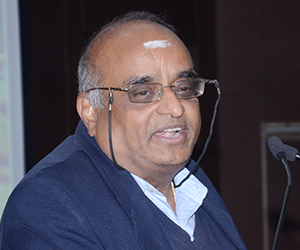As per Angus Maddison’s pioneering OECD study, India and China had nearly 50 percent of the global GDP as late as the1820‘s.1 Hence, India and China are not emerging or rising powers. They are merely retrieving their original position or re-emerging markets. In 1990, the share of G-7 in world GDP [on PPP base] was 51 % and that of the emerging markets was 36 %. But in 2014 it is the reverse. [See Chart 1].
The crisis faced by the West is primarily due to forgetting a six letter word called ‘saving’ which is a result of forgetting another six letter word called ‘family’. The West has nationalized families over the last sixty years. Old age, ill health, single mother, child care everything is the responsibility of the State. When family is a ‘burden’ and children an ‘encumbrance’, society can be said to be in a state that should cause concern. Actually, for long household savings has been negative in the USA

We find from Table -- 1 that the Debt to GDP ratio is above 300% in many developed countries. Importantly, the Household Debt to GDP ratio is significantly high in many G-7 countries like US, UK, Canada etc. and comparatively low in countries like China and India. Saving is still not forgotten in these countries. Also, the credit card culture could be a major reason for such high levels of indebtedness in the developed countries.
We have given in table-2 the household savings rate as percentage of disposable income for many OECD countries. Except France, most are in single digits. The lack of savings by households has an impact not only on the current situation but also on distribution of wealth over time. We can use a thumb rule to conclude that whenever the savings rate of a society is less than 10% of its disposable income [with stable taxation and inflation] then the society is bound to get into difficulties. Many households begin to rely more and more on social security and this liability, in some countries, is either not funded, or, inadequately funded. This, in turn creates substantial issues of solvency of the government and the ability of the government to take care of the old age security of its citizens.

Source: Household savings—OECD fact book. [http://www.oecd.org/dataoecd/5/48/2483858.xls]
This, coupled with the declining population growth rate and longevity of the current generation, creates an explosive situation of a bankrupt state exchequer and lower accretion to the social security fund.
The decline, and in many cases, the extinction of the joint family system in these countries adds to the agony of the elderly in terms of their old age security and health and emotional care. The increasing number of children born out of wedlock to younger girls and single mothers creates additional dependency numbers for the State. The consumption driven society turns out to be a ‘Responsibility Denial’ society. A couple of years ago, hundreds of aged people died in France from the heat due to lack of care by their family and the State. Younger family members had all gone on vacation in the summer leaving the old to the vagaries of nature. And the State is blamed for not taking care of the old! The slogan of ‘Shop till you drop’ is slowly changing to ‘Shop and get dropped’. Consumers are feted and savers are frowned upon. But the wheel is slowly but surely turning. Suddenly the good old virtues of saving and thrift are becoming the fashion from Alberta to Auckland. The limits to consumption led growth have at last dawned upon the people. On a global scale, the consumption led growth of some countries like the USA is supported by saver countries in the developing world. But how long can these anomalies continue?
Not only that, the West is also facing a severe demographic crisis. The population of Europe at the time of the First World War was nearly 25% percent of the world’s population; today, it is around 11% and is expected to become 3% in another twenty years. [See Chart -- 2] Europe will disappear from the world map unless migrants from Africa and Asia take it over. The demographic crisis impacts them in other ways too. The Social Security system goes for a toss since people are living longer and there aren’t sufficient numbers to contribute towards the Social Security fund or pay taxes. So the nationalization of families becomes a burden on the state. European work culture has also deteriorated with even our own Tata complaining about the work ethics of British managers
In UK, the situation is worst with alcoholism becoming a common problem. The Chief Rabbi of the United Hebrew Congregation in London says, “There are all signs of arteriosclerosis of a culture and a civilization grown old. Me has taken precedence over We and pleasure today over viability tomorrow.” [The Times, 08-09-2011]. Married couples make up less than half [45%] of all households in the USA says the recent data from the Census Bureau. Also, there has been huge growth in unmarried couples and single parent [mostly poor black women] families. Society has become dysfunctional or disorganized in the West. The Government is trying to be organized. In India, society is organized and Government is disorganized. Because of the disorganized society in the West, the state has to take care of families. The market crash is essentially due to the model of consumption with borrowings and no savings.
According to a recent report [Wall Street Journal, 10-10-2011], nearly half of the U.S. population lives in households receiving government benefits like food stamps, subsidized housing, cash welfare or Medicare or Medicaid (the federal-state health care program for the poor) or Social security etc.
The unemployment rate in many European countries like Spain and Greece is more than 20% and among youth (aged 16 to 24 years) it is nearing 50%.2,3
Britain has fallen out of love with marriage. The 2011 Census shows that the number of married people has fallen to 20.4 million, nearly 200,000 less than a decade ago. A quarter of the people in England and Wales are single, while the number of those cohabiting has risen from 9.8% of the population to 11.9 %. Growing numbers of people are also choosing to divorce.
The breaking up of the family has put tremendous pressure on the state to sustain single parent/single women families and also the elderly. This has put their social security schemes – if at all funded – under strain.
Europe has become secular, which is a euphemism for renouncing or ignoring the church. For instance, the recent census in the UK has revealed that there has been a decline of 12% in people belonging to Christianity and 25% of the population said they had no faith – an increase from 15% a decade earlier.
The UK is also exhibiting tendencies in societal behavior more typical of third world countries. For instance, urinating in the streets is becoming a major issue and the town of Chester is using innovative ways to punish offenders like asking them to maintain local heritage sites.
The French are grappling with the issues of illegitimacy and a failure of the family system. An ex-French law minster had simultaneous relationships with eight men and it was difficult to ascertain who the father of her child was. In another decade, many French children may be able to identify their fathers only through DNA tests.
The USA is facing similar issues. In 2010, more than 50% of the children were born out of wedlock and illegitimacy is the new norm. Among blacks, it is 75% and among Latinos, it is more than 55%.4,5,6
The US faces an unprecedented crisis since families have been nationalized and businesses privatized. Society has become dysfunctional. This year, more than half the births are of non-white children, giving rise to the possibility of the US becoming a non-white majority country in another 30 years where Spanish and Chinese could become major languages. This could have a tremendous impact in Mid-West and give Southern Bible-thumpers like Rush Limbaugh a field day. This could also give rise to sharper social conflicts and open up the old civil war fault lines.
Two reports released in December 2012 in the US will have significant and far-reaching implications for countries like India. These reports are: Global Trends 2030: Alternative Worlds, by the US National Intelligence Council, and US Strategy for a Post-Western World: Envisioning 2030, by the Atlantic Council.
The aforementioned two reports tell us something we always hesitate to believe till someone from the West confirms it for us. The reports indicate how China and India will be more powerful than the US by 2030. One of the reports also suggests that Asian cultures will supersede America’s and Europe’s in 20 years as the global middle class grows. But it also predicts that competition for resources, including food, space and water, will be fierce.
Five trends which will have far-reaching implications for the West and us are the following:
- The West’s problems are related to the decline of the family as an institution and household savings.
- Demography is increasing the proportion of old people in the population.
- Rising longevity is leading to a social security crisis which will bankrupt governments.
- The decline of the Church and belief systems – both in Europe and US – could have major implications.
- The Westphalia Consensus about the sovereignty of nations which are not western/white is over.
These trends have not been dealt with in full detail in the main reports possibly because they are focused more on economics, energy etc. But the building blocks of any civilization start with the family, and this has become an issue in the western world, without alternate institutions emerging.
Under the circumstances India needs to strategize for the future.
We should recognize that for most of the Indian elite, their umbilical cords are linked to the west. Many of them are/were educated in the US or Europe, and most of them have their children studying or working there. Due to colonial genes, acceptance and recognition by the West is critical for average middle class Indians.
The danger is that we are going to replicate their failed models when they are in decline. They will try to sell us everything they have, and we will buy it because of our colonial genes. They will hire more Indians to head global companies as showpieces in order to penetrate our markets.
The reality that the West is in decline and many of its institutions are failing has still not struck us and we will continue to try and imitate them – including their dysfunctional family systems. We should recognize that we are a civilization and not just a market. Today, funds are in search of markets and not the other way round. Instead of heading global institutions, we should prepare to acquire them.
Civilisationally, we are nearer to the East than the West. We should take the lead along with others in the East to create alternative institutions to the World Bank, the IMF and the UN. The need is to recognize that the old debate about big business or big government is passé. Our ability to look beyond Marx and market into our thriving communities and bazaars will provide us answers to many issues.
Will India, as Aurobindo mentioned, rise from the ruins of the West?
Chart – 1

Chart-2

References:
- Table-B-20 Appendix B; pp263; The World Economy: A millennial Perspective—Angus Maddison OECD Development Centre Studies –2007
- http://www.nytimes.com/interactive/2012/02/16/business/mixed-prospects-for-europes-young-workers.html
- http://www.businessandfinance.ie/bf/2012/2/feb2012mkts/globalyouthunemployment2012
- http://www.economist.com/news/united-states/21569433-americas-marriage-rate-falling-and-its-out-wedlock-birth-rate-soaring-fraying
- http://parenting.blogs.nytimes.com/2012/02/19/for-younger-mothers-out-of-wedlock-births-are-the-new-normal/
- http://www.nytimes.com/2012/02/18/us/for-women-under-30-most-births-occur-outside-marriage.html?pagewanted=all
Published Date: 9th September 2014, Image source: http://si.wsj.net
(Disclaimer: The views and opinions expressed in this article are those of the author and do not necessarily reflect the official policy or position of the Vivekananda International Foundation)









Post new comment